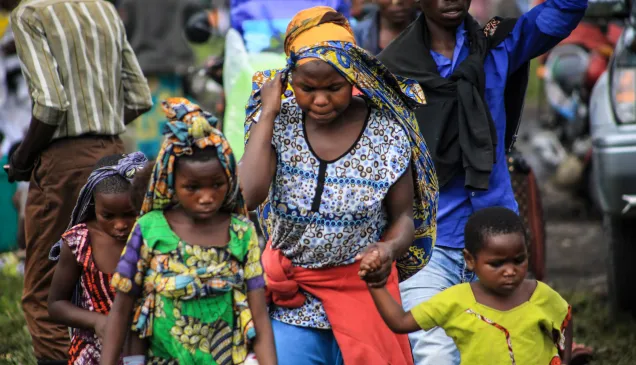DR Congo : Ensuring access to water a priority in wake of volcanic eruption near Goma

The eruption of Mount Nyiragongo on 22 May 2021, caused significant damage to homes, hospitals and water-supply infrastructure in nearby Goma, and displaced several thousand people. The International Committee of the Red Cross (ICRC) has been working hard to ensure that everyone has access to water and health care, and help with finding missing loved ones.
"I have no money – I have nothing," says Emmanuel Grâce Billy. "When we heard the governor's order to evacuate Goma, we grabbed our things and fled on foot." Emmanuel and his family sought refuge in the town of Sake, some 20 km northwest of Goma.
Two weeks later, on 7 June, the Congolese authorities announced that people could start making their way home, but prohibited any return to areas devastated by the lava.

Many of those who fled or evacuated their homes lost everything. On 12 June, we distributed food and other essentials to 15,000 people displaced by the eruption.
According to the United Nations, 4,000 families have lost their homes completely and a further 1,000 houses have sustained damage. On 7 June, the Congolese authorities announced that people could gradually start returning home, but prohibited any return to areas devastated by the lava.
Some people settled in temporary sites, while others were taken in by host families.

The Goma Volcano Observatory has recorded a steady decrease in seismic activity but has not ruled out the possibility of a further eruption. Surveillance measures have been stepped up and caution urged.</h2>
The water-supply network in the northern part of Goma was damaged by the lava flow. We used tankers to supply water to affected neighbourhoods and certain hospitals. Water pipes and a reservoir in the Munigi neighbourhood were badly damaged, leaving 550,000 people without any drinking water.
"We trucked in water shortly after the eruption," explains Raphael Tenaud, head of the ICRC subdelegation in Goma. "People were having to travel some seven kilometres to collect water from Lake Kivu, then trek back up a steep hill carrying as much as 80 litres of water. And they were doing this several times a day."

The reservoirs that we refilled are connected to public water fountains. These are free to use for the time being, much to people’s delight.

Before the eruption, people had to pay a small fee to use these water points. Access to drinking water in Goma and the surrounding area has been a serious problem for several years now, not least due to increased demand: recurrent armed conflict in the region has forced many people to flock here.</h2>
Water has always been an issue in Goma. With no citywide supply network, tens of thousands of people are forced to use public fountains or purchase water elsewhere. You can buy it on the streets but the quality is questionable and the price highly inflated. The poorest people are disproportionately affected by this situation.

As well as ensuring an emergency supply of water for those in need, we are working with the national water board to repair pipes damaged by the lava and restore this essential service in the long term.</h2>

Over 250 unaccompanied children were evacuated to the Don Bosco de Shasha centre, 40 km from the city of Goma. We installed a temporary water point to meet their daily needs.
We provide technical, logistical and financial assistance to the Red Cross Society of the Democratic Republic of the Congo, to support their efforts to reunite or restore contact between separated family members. Since 23 May, more than 180 unaccompanied children have been identified in the North Kivu province and over 140 of them have already been reunited with their families.

“I’m so happy!” cries Pierrette Mihindano, overjoyed at being reunited with three of her five children, from whom she had become separated in the chaos of evacuating Goma.
The authorities ordered people to evacuate the city a few days after the eruption, in case of a potential second eruption. While Pierrette has been reunited with her children, others have still not heard from their loved ones.
Another focus of our efforts in Goma and across the region is health care. In areas where people have flocked for safety, health-care facilities are feeling the strain. We are helping to boost their capacity to meet the increased demand.

Special support is being given to Ndosho hospital, which received several sick patients evacuated from other health facilities when the volcano erupted. Two tents have been erected to treat patients referred by other facilities. We are continuing to perform surgery and provide medical supplies, medications, power and water. </h2>
Looking ahead, it is predicted that cases of various diseases will increase among the 15,000 people affected by the eruption of Mount Nyiragongo. With this in mind, we have distributed medical supplies to health centres in Kimoka, Kaduki, Munigi, Majengo and Bojovu, and to hospitals in Minova, Virunga, Ndosho and Kyeshero. This assistance has enabled us to provide surgical treatment to over 100 patients.
Additionally, we are supporting the Tulizo Letu mental health centre, which has taken in 110 evacuees with reduced mobility.



